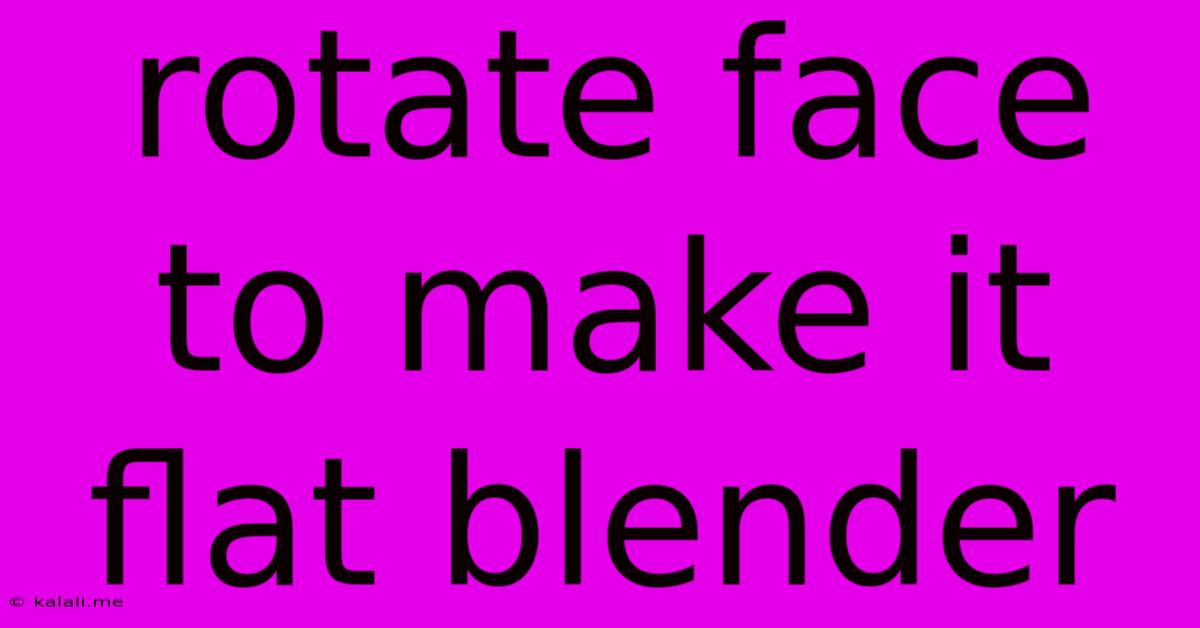Rotate Face To Make It Flat Blender
Kalali
May 23, 2025 · 3 min read

Table of Contents
Rotating Faces to Achieve a Flat Surface in Blender: A Comprehensive Guide
This article provides a detailed walkthrough on how to effectively rotate faces in Blender to create a flat surface. We'll cover various techniques, suitable for beginners and intermediate users, ensuring you can achieve professional-looking results. Whether you're modeling a building, a piece of furniture, or anything requiring precise planar surfaces, mastering this skill is crucial. This guide will cover everything from basic selection methods to advanced techniques for complex meshes.
Understanding Face Orientation and Normal Vectors
Before diving into the rotation process, it’s essential to understand face orientation. Each face in Blender has a normal vector – an invisible line pointing outwards, perpendicular to the face. This normal vector determines the direction of the face. To make a face flat, we need to align its normal vector with the desired plane (XY, XZ, or YZ). Misaligned normals are often the culprit behind uneven surfaces.
Method 1: Using the Rotate Tool (for Simple Adjustments)
This is the most straightforward method, ideal for minor adjustments or single faces.
- Select the Face: In Edit Mode, select the face(s) you want to rotate using the mouse. You can use the box select, circle select, or lasso select tools for precision.
- Activate the Rotate Tool: Press "R" on your keyboard.
- Specify Rotation Axis: Blender will prompt you to specify the axis. Use X, Y, or Z to rotate around the respective axis. You can also use a combination like "RX" or "RY" to constrain the rotation.
- Enter Rotation Value: Enter the desired angle value, or click and drag to rotate visually. Precise values are often easier to achieve this way.
- Confirm Rotation: Once you're satisfied, press Enter or left-click to confirm the rotation.
Remember, you can use the "Snap to" options in the toolshelf (press "T") to snap to increments, ensuring precise rotations.
Method 2: Using the Normal Editing Tools (for Complex Adjustments)
For multiple faces or complex situations where aligning normals is crucial, Blender's normal editing tools are invaluable.
- Select Faces: Select the faces requiring flattening.
- Access Normal Editing: In the toolshelf (press 'T'), locate the "Normals" section.
- Recalculate Normals: Click "Recalculate Normals Outside" or "Recalculate Normals Inside", depending on the desired direction. This is particularly useful if your faces are inverted.
- Set Normals: Use the "Set Normals" option to align selected faces to a specific axis. This ensures perfect alignment.
This method helps resolve many issues related to uneven or flipped normals, making for cleaner and more consistent models.
Method 3: Using Vertex Manipulation (for Fine-tuning and Complex Shapes)
For intricate shapes or fine adjustments, manipulating individual vertices provides the most control.
- Select Vertices: Switch to vertex select mode and choose the vertices you want to adjust.
- Use the Translate Tool: Press "G" to activate the Grab tool. Then constrain the movement to one axis (X, Y, or Z) using the corresponding key.
- Precise Movement: Use this method to nudge vertices into precise positions, ensuring a flat surface.
This offers granular control over surface flatness, ideal for complex modelling scenarios.
Troubleshooting and Tips
- Non-manifold Geometry: Problems often arise with non-manifold geometry. Ensure your mesh is correctly constructed without overlapping or intersecting faces.
- Use Snapping: Leverage Blender's snapping tools for precise alignment and consistency.
- Check Normals: Regularly check your normals to ensure they point in the correct direction using Blender's normal visualization options.
By utilizing these methods, you can effectively rotate faces in Blender and achieve perfectly flat surfaces. Remember to experiment with different techniques to find the best approach for your specific modeling project. Mastering this skill will significantly enhance the quality and efficiency of your 3D modeling workflow.
Latest Posts
Latest Posts
-
Raspberry Pi Emulation On Mac From Sd Card
May 23, 2025
-
Sabbath Prayer Fiddler On The Roof
May 23, 2025
-
Search Filters On Left Or Right
May 23, 2025
-
How Long To Trickle Charge A Car Battery
May 23, 2025
-
Componentprofiler Component Level Profiling Has Not Been Enabled
May 23, 2025
Related Post
Thank you for visiting our website which covers about Rotate Face To Make It Flat Blender . We hope the information provided has been useful to you. Feel free to contact us if you have any questions or need further assistance. See you next time and don't miss to bookmark.